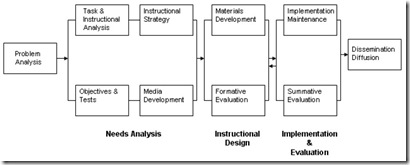And so my friends, we reach Number 20 in our journey of discovery around Instructional Design. That's a month's solid blogging, investigating one of the fundamental domains associated with our profession.
What have we learned? More of that anon, but for now I'm going to cover the the Seels and Glasgow Model in this E-Learning Curve Blog series on a systems approach to instruction design.
Now read on…
In a 2008 article called Can we reinvent e-learning? I asserted that
ADDIE emerged from the principles of project management, and resembles the philosophy and practice to this discipline's methodology more than a pedagogy. Treating learning like a project leads to "training outcomes" equivalent to project deliverables.
In my view this is no bad thing: the reality is that Learning & Development is a pragmatic discipline, tasked with facilitating individuals in their endeavors to learn, educators would be poorly served if the theoretical, methodological, and pedagogical epistemologies of the domain did not at least tacitly acknowledge the practical challenges associated with implementing learning programs.
Barbara Seels and Zita Glasgow's Model (see Figure 1) reflect this assertion; they situate their understanding of ISD and their model on the thesis that design occurs in the context of project management (p. 177).
Figure 1. The Seels and Glasgow Model
[Click to enlarge]
Their model is distributed across the three phases of project management:
- Needs Analysis Management
- Instructional Design Management
- Implementation Management
This distribution allows a learning program (or project) to be planned, resourced, and managed much as any other project in an organization is arranged.
In this model, the first phase (Needs Analysis) includes the establishment of the instructional goals, requirements, and context for the courseware. Next, the Instructional Design phase begins when Needs Analysis is completed: this second phase consists of six activities:
- task analysis
- instructional analysis
- objectives and tests
- formative evaluation
- materials development
- instructional strategy and delivery systems
- all of which are linked via feedback and interaction communications channels. In Phase Three of the model (Implementation and Evaluation) the development and production of materials, training delivery, and summative evaluation are undertaken.
As is usual in a systems-based approach to ID, the phases in this model can are typically applied in a linear fashion, but they are often applied iteratively. As Gustafson and Branch highlight, the steps in the instructional design phase are interdependent and concurrent, and multiple iterations of this process may occur during this part of the development lifecycle (2001, p.43).
In this sense - and reflecting on my ADDIE/PM remarks, we can say that this is a product-oriented approach to content development. According to Chen
Developing an instructional project involves skill sets ranging from project management and interface design to sound preparation and programming...Design teams represent various fields of expertise (producers, instructors, editors, etc.).
(2007 pp.2-3)
Managing potentially large teams and and hundreds (if not thousands) of media assets needs substantial resources and commitment, and requires strong project management to stay on time and budget at the appropriate quality of outputs. To support this objective, Seels and Glasgow focus on the importance of well-designed materials, the need to identify and understand communication patterns within organizations, develop strategies for diffusion of innovations, and the importance of supporting learners.
Interestingly, Seels and Glasgow also include the concept of diffusion of innovations in their model:
The strategies that lead to diffusion are most effective if used during all the phases of a project.
(1998, p. 178)
They consider that when their model is applied ,the phases are generally linear in nature but
it is not necessary to complete a step before proceeding, and the order can be changed so that steps can be performed concurrently.
(1998, p 179)
We can say that this model successfully aligns to the systems philosophy epitomized in ADDIE quite will, while acknowledging the needs and limitations of the practical application of instructional design. Much like 3PD, formative evaluation via a feedback mechanism (multiple iterations rather than recursion) is a distinguishing (but not unique) characteristic of Seels and Glasgow's approach.
Next time: What have we learned? The implications of Instructional Systems Design for E-Learning
___________
References:
Chen, I. (2007) Instructional Design Methodologies. In: Kidd, T. & Song, H. (Eds.). Handbook of Research on Instructional Systems and Technology. IGI Global
Seels, B. & Glasgow, Z. (1990). Exercises in instructional Technology. Columbus OH: Merrill Publishing Co.
Seels, B., & Glasgow, Z. (1998). Making Instructional Design Decisions. (2nd ed.) Upper Saddle River, NJ: Merrill.
--






No comments:
Post a Comment